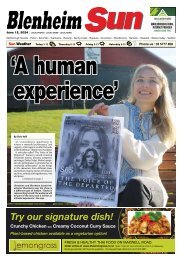Southern View: July 22, 2021
Create successful ePaper yourself
Turn your PDF publications into a flip-book with our unique Google optimized e-Paper software.
SOUTHERN VIEW Latest Canterbury news at starnews.co.nz<br />
Thursday <strong>July</strong> <strong>22</strong> <strong>2021</strong> 5<br />
Bid to find more homes<br />
for abandoned dogs<br />
A CITY council<br />
partnership to retrain<br />
dogs for adoption with<br />
a Bromley-based animal<br />
shelter has resulted in<br />
almost all dogs being<br />
rehomed last year.<br />
The collaboration is<br />
between the city council’s<br />
animal services team<br />
and Dogwatch Sanctuary<br />
Trust, as well as the<br />
Christchurch Bull Breed<br />
Rescue in Woolston.<br />
“Working with Christchurch<br />
Bull Breed Rescue<br />
and Dogwatch Sanctuary<br />
Trust is a key part of<br />
our focus on rehoming<br />
dogs,” city council animal<br />
services manager Lionel<br />
Bridger said.<br />
“These two organisations,<br />
together with shelter staff,<br />
play a vital role in helping<br />
to re-train dogs so that they<br />
can be adopted out.”<br />
When animal services<br />
find dogs that are not microchipped<br />
and ownership<br />
cannot be confirmed, or<br />
when dogs are not collected<br />
by their owners after<br />
seven days, the city council<br />
looks to what other options<br />
they have to avoid what<br />
would have historically<br />
resulted in euthanasia.<br />
“Shelter staff now assess<br />
the dog’s temperament<br />
over a period of time and<br />
determine with work by<br />
either Dogwatch or Bull<br />
Breed Rescue whether the<br />
dog would be suitable for<br />
rehoming.<br />
“If they are, we would<br />
hold dogs for up to a<br />
month until there is space<br />
available for them.<br />
“The dogs are then<br />
rehomed from the shelter<br />
to one of the organisations,<br />
who put a lot of work in to<br />
ensure they find the right<br />
owner,’’ Bridger said.<br />
The collaborative approach<br />
has dramatically<br />
reduced the number of<br />
PHOTO CREDIT:<br />
KAREn<br />
MOfFATT-MCLEOd<br />
FOREVER HOME: Christchurch Bull Breed<br />
Rescue founder Abbey Vanderplas has partnered<br />
with the city council to retrain abandoned dogs,<br />
allowing more of them to be adopted out. <br />
dogs being euthanised by<br />
the city council.<br />
Last year the city council<br />
placed 675 dogs in the<br />
animal shelter.<br />
Of those 563 were<br />
returned to their owners,<br />
47 referred to Dogwatch<br />
and Bull Breed Rescue for<br />
rehoming and 50 rehomed<br />
directly from the Shelter.<br />
Only 15 dogs were<br />
euthanised. By contrast,<br />
Auckland City Council<br />
figures for last year show<br />
that 5492 dogs were impounded,<br />
1388 euthanised<br />
and just 372 adopted.<br />
Dogwatch’s adoption<br />
centre manager Kelly Burt<br />
said the dogs come to them<br />
with a variety of issues including<br />
poor socialisation,<br />
barking, nipping and fence<br />
jumping.<br />
Once specific behaviours<br />
were identified, Dogwatch<br />
develops a training plan<br />
before looking for a suitable<br />
home.<br />
Said Burt: “We don’t<br />
want them to bounce<br />
around, we want these<br />
dogs to go to homes and<br />
stay there so we aim to<br />
VOTE<br />
nOw!<br />
make a match between<br />
what the owner can<br />
provide and what the dog<br />
needs. It’s about that willingness<br />
to work together.”<br />
Abbey Vanderplas is one<br />
of two full-time, trained<br />
volunteers at the Bull<br />
Breed Rescue.<br />
She works with more<br />
than 20 other volunteers<br />
and foster carers to provide<br />
support for pitbulls,<br />
staffordshire terriers, bull<br />
terriers and their crosses.<br />
She founded the organisation<br />
10 years ago after<br />
adopting a staffordshire<br />
puppy from the city council<br />
shelter and realising<br />
the difficulties bull breed<br />
dogs faced in finding new<br />
homes.<br />
Vanderplas said there<br />
was an “old school mentality”<br />
that just is not there<br />
today.<br />
“It took time to lift that<br />
stigma but Christchurch<br />
now is really lucky with<br />
our animal management.<br />
For a large city we are<br />
doing phenomenally well<br />
at making sure good dogs<br />
get a chance.”<br />
PEOPLE’S CHOICE AWARD <strong>2021</strong><br />
YOUR VOTE<br />
MATTERS MOST!<br />
For the first time, the<br />
Kiwi Gardener Bird Photo<br />
Competition includes a<br />
People’s Choice Award,<br />
where your vote matters<br />
the most. The winner<br />
will have their bird pride<br />
of place in a stunning<br />
20<strong>22</strong> calendar.<br />
?<br />
SELECT UP TO THREE FAVOURITES!<br />
VOTE OnLInE AT KiwIgARDEnERMAgAzinE.CO.nz<br />
*Terms and conditions apply, voting ends August 11, <strong>2021</strong>.<br />
No one day is ever the same at McMaster<br />
& Heap Vets. Last Wednesday night we<br />
got an urgent call that a GSP, aptly named<br />
“Maximus Carnage” had ingested 250g<br />
of 50% Chocolate with 250ml cream.<br />
Max cleverly lifted the pot of cream<br />
and chocolate off the stove and licked<br />
ravenously at its contents while his<br />
humans had left the kitchen. Chocolate is<br />
very poisonous to dogs, especially the dark<br />
variety, so we urged Max’s owners to rush<br />
him into us before close.<br />
On arrival Max looked excited to be in our<br />
waiting room, saying hello to the other<br />
waiting patients. Kirsty was the first to<br />
see Maximus and tried to make him sick<br />
up the chocolate with a double dose of<br />
medication popped into the conjunctival<br />
sac, that is supposed to induce vomiting.<br />
Nope! Max wasn’t giving up his chocolate<br />
feast easily. Chocolate is slowly absorbed<br />
from the stomach so you have about 4-6<br />
hours to make them sick.<br />
All that ingested chocolate could have<br />
had dire consequences for Max, so Kirsty<br />
quickly anaesthetised Max, stomach<br />
tubed him to remove the chocolate and<br />
copiously lavaged his stomach to remove<br />
every trace. She retrieved 1/2 a bucket<br />
of chocolate. Then she poured activated<br />
Charcoal down his tube to help soak up<br />
any remains of chocolate. Max was placed<br />
on intravenous fluids to help excretion<br />
of the methyxanthine and provide<br />
cardiovascular support. Caffeine can be<br />
reabsorbed across the bladder wall and<br />
this can prolong the duration of clinical<br />
signs so fluids and frequent urinations are<br />
highly recommended. Max was closely<br />
monitored until he was awake and then<br />
sent to the After Hours clinic for overnight<br />
care.<br />
Chocolate is directly toxic to dogs as it<br />
contains methylxanthines - in particular<br />
Theobromine and Caffeine. Initially dogs<br />
may vomit, drink lots, start tremoring and<br />
become restless and agitated. As toxicosis<br />
progresses their hearts rate quickens,<br />
blood pressure elevates,<br />
they become hot, rigid<br />
and may start to seizure.<br />
Sometimes they can just<br />
die from toxic levels. Other<br />
toxic products with the<br />
methylxanthines are cocoa<br />
and coffee beans, diet<br />
pills, cold medications,<br />
Guarana, stimulant pills,<br />
tea leaves, energy drinks<br />
and coffee.<br />
McMaster & Heap<br />
Veterinary practice<br />
Max’s CHOCOLATE Party<br />
Max waking<br />
up from<br />
anaesthesia<br />
with nurse<br />
Olivia by<br />
his side<br />
Maximus under<br />
anaesthesia<br />
getting the<br />
chocolate out<br />
Open 7 days<br />
Cnr Hoon Hay & Coppell place<br />
phone 338 2534, Fax 339 8624<br />
e. mcmasterandheap@yahoo.co.nz<br />
www.mcmasterheap.co.nz<br />
Dark unsweetened chocolate, cocoa<br />
powder and cacao beans are the<br />
worse in milligrams of methylxanthines<br />
contained. White chocolate has virtually<br />
no methylxanthines but is just high in fat<br />
and could lead to pancreatitis. There is a<br />
chocolate calculator online to work out<br />
whether your dog has ingested a lethal<br />
dose and needs to seek vet attention.<br />
Max was lucky that his owners realised<br />
what he had done and sought our help<br />
immediately. Having 3 vets on that<br />
Wednesday night, meant Steve and I could<br />
cover Kirsty’s consults so she could spent<br />
1.5 hours working on Max. The After-hours<br />
clinic wasn’t open at this stage and he<br />
needed gastric emptying immediately.<br />
Max and<br />
his family<br />
Very pleased to say Maximus Carnage<br />
has made a full recovery but this won’t<br />
Max, the<br />
Chocolate<br />
eating dog<br />
stop him attempting to<br />
steal more chocolate<br />
in the future. Prognosis<br />
depends on type and<br />
quantity of chocolate<br />
ingested, body weight<br />
of the dog and the time<br />
lapse between eating and<br />
being made to vomit. Max<br />
had a lucky escape.<br />
Dr Michele McMaster<br />
McMaster & Heap


















